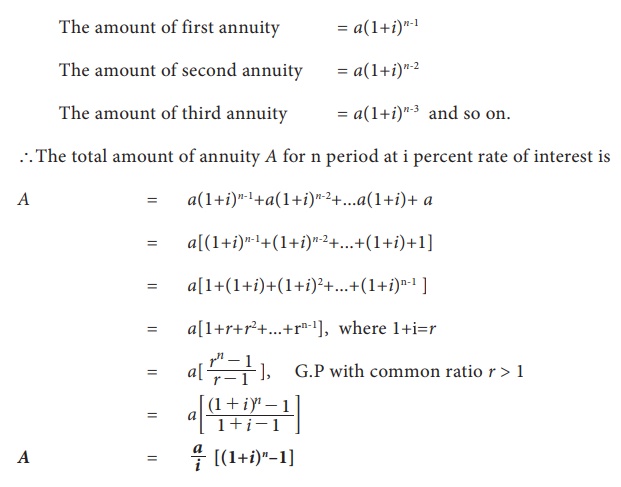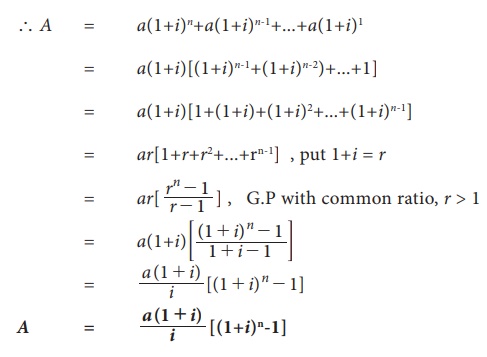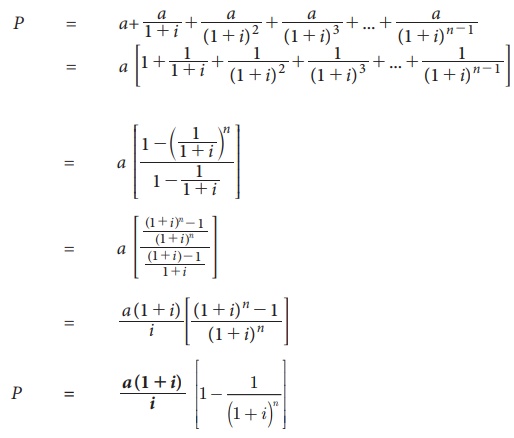Financial Mathematics - Types of annuities | 11th Business Mathematics and Statistics(EMS) : Chapter 7 : Financial Mathematics
Chapter: 11th Business Mathematics and Statistics(EMS) : Chapter 7 : Financial Mathematics
Types of annuities
Types of annuities
a) Based on the number of periods:
(i) Certain annuity: An annuity payable
for a fixed number of years is called certain annuity.
Installments of payment for a
plot of land, Bank security deposits, purchase of domestic durables are
examples of certain annuity. Here the buyer knows the specified dates on which
installments are to be made.
(ii) Annuity contingent: An annuity payable at regular interval of time till the happening of a
specific event or the date of which cannot be accurately foretold is called
annuity contingent.
For example the endowment funds
of trust, where the interest earned is used for welfare activities only. The
principal remains the same and activity continues forever.
All the above types of annuities
are based on the number of their periods. An annuity can also be classified on
the basis of mode of payment as under.
b) Based on the mode of payment :
(i) Ordinary annuity: An annuity in which
payments of installments are made at the end of each period is called ordinary
annuity (or immediate annuity)
For
example repayment of housing loan, vehicle loan etc.,
ii) Annuity due: An annuity in which
payments of installments are made in the beginning of each period is
called annuity due.
In annuity due every payment is
an investment and earns interest. Next payment will earn interest for one
period less and so on, the last payment will earn interest of one period.
For
example saving schemes, life insurance payments,
etc.,
The derivation of
the following formulae are given for better understanding and are exempted from
examination
(i) Amount of immediate annuity (or) Ordinary annuity (or) Certain annuity
Let ‘a’ be the ordinary annuity and i
percent be the rate of interest per period. In ordinary annuity, the first
installment is paid after the end of first period. Therefore it earns interest
for (n – 1) period, second
installment earns interest for (n –
2) periods and so on. The last installment earns for (n – n) periods. (i.e)
earns no interest.
For (n–1) periods,
The amount of first annuity = a(1+i) n-1

(ii) Present Value of immediate annuity (or ordinary annuity)
Let ‘a’ be the annual payment of an ordinary annuity, n be the number of years and i percent be the interest on one rupee
per year and P be the present value
of the annuity. In the case of
immediate annuity, payments are made periodically at the end of specified period. Since the first installment is paid
at the end of first year, its present value is a / 1+i , the present value of
second installment is a / (1+i)2 and so on. If the present value of
last installment is a / (1+i)n , then we have

(iii) Amount of annuity due at the end of n period
Annuity due is an annuity in
which the payments are made at the beginning of each payment period. The first
installment will earn interest for n
periods at the rate of ‘i’ percent
per period. Similarly second installment will earn interest for (n – 1) periods, and so on the last
interest for on period.

(iv) Present value of annuity due
Since the first installment is
paid at the beginning of the first period (year), its present value will be the
same as ‘a’, the annual payment of
annuity due. The second installment is paid in the beginning of the second
year, hence its present value is given a / (1+ i) and so on. The last
installment is paid in the beginning of nth year, hence its present value is
given as a / (1+ i)n-1

If P denotes the present value of annuity due, then

(v) Perpetual
Annuity
Perpetual annuity is an annuity
whose payment continuous for ever. As such the amount of perpetuity is
undefined as the amount increases without any limit as time passes on. We know
that the present value P of immediate
annuity is given by

Now as per the definition of
perpetual annuity as n → ∞, we know
that  since 1+i > 1.
since 1+i > 1.

NOTE
In all the above
formulae the period is of one year. Now if the payment is made more than once
in a year then ‘i’ is replaced by i/k and n is replaced by nk,
where k is the number of payments in
a year.
Related Topics